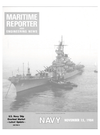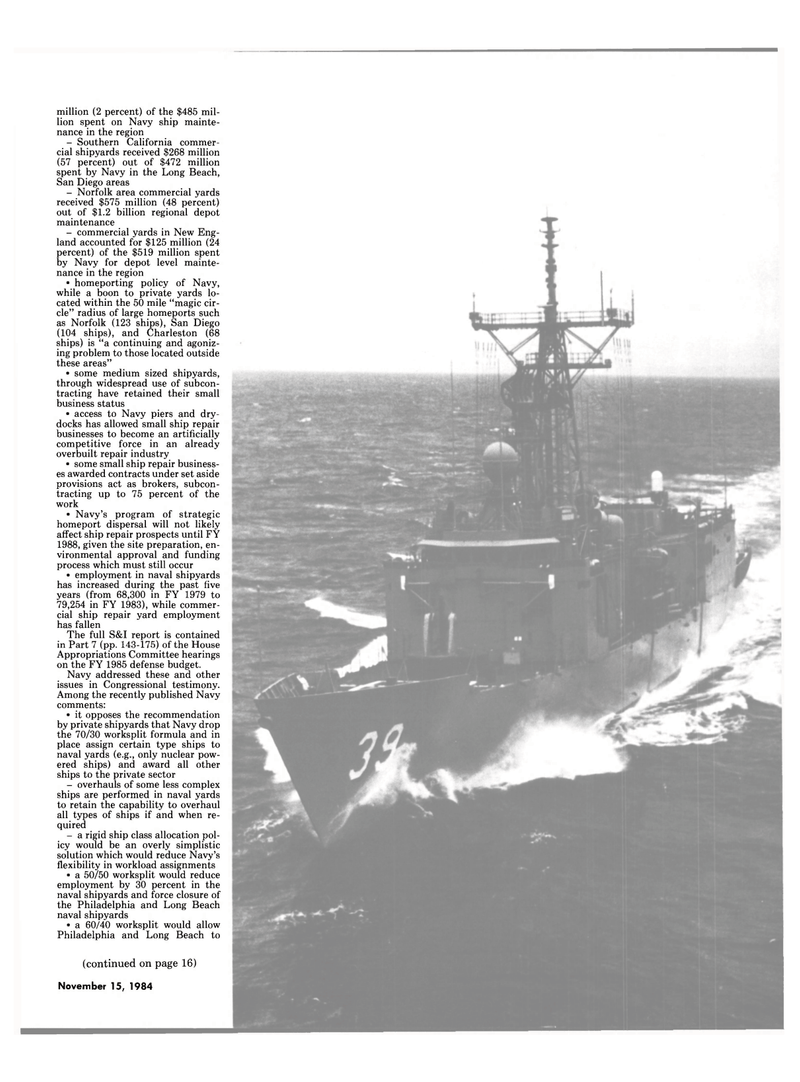
Page 11: of Maritime Reporter Magazine (November 15, 1984)
Read this page in Pdf, Flash or Html5 edition of November 15, 1984 Maritime Reporter Magazine
million (2 percent) of the $485 mil- lion spent on Navy ship mainte- nance in the region - Southern California commer- cial shipyards received $268 million (57 percent) out of $472 million spent by Navy in the Long Beach,
San Diego areas - Norfolk area commercial yards received $575 million (48 percent) out of $1.2 billion regional depot maintenance - commercial yards in New Eng- land accounted for $125 million (24 percent) of the $519 million spent by Navy for depot level mainte- nance in the region • homeporting policy of Navy, while a boon to private yards lo- cated within the 50 mile "magic cir- cle" radius of large homeports such as Norfolk (123 ships), San Diego (104 ships), and Charleston (68 ships) is "a continuing and agoniz- ing problem to those located outside these areas" • some medium sized shipyards, through widespread use of subcon- tracting have retained their small business status • access to Navy piers and dry- docks has allowed small ship repair businesses to become an artificially competitive force in an already overbuilt repair industry • some small ship repair business- es awarded contracts under set aside provisions act as brokers, subcon- tracting up to 75 percent of the work • Navy's program of strategic homeport dispersal will not likely affect ship repair prospects until FY 1988, given the site preparation, en- vironmental approval and funding process which must still occur • employment in naval shipyards has increased during the past five years (from 68,300 in FY 1979 to 79,254 in FY 1983), while commer- cial ship repair yard employment has fallen
The full S&I report is contained in Part 7 (pp. 143-175) of the House
Appropriations Committee hearings on the FY 1985 defense budget.
Navy addressed these and other issues in Congressional testimony.
Among the recently published Navy comments: • it opposes the recommendation by private shipyards that Navy drop the 70/30 worksplit formula and in place assign certain type ships to naval yards (e.g., only nuclear pow- ered ships) and award all other ships to the private sector - overhauls of some less complex ships are performed in naval yards to retain the capability to overhaul all types of ships if and when re- quired - a rigid ship class allocation pol- icy would be an overly simplistic solution which would reduce Navy's flexibility in workload assignments • a 50/50 worksplit would reduce employment by 30 percent in the naval shipyards and force closure of the Philadelphia and Long Beach naval shipyards • a 60/40 worksplit would allow
Philadelphia and Long Beach to (continued on page 16)
November 15, 1984

 10
10

 12
12
